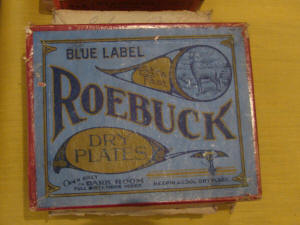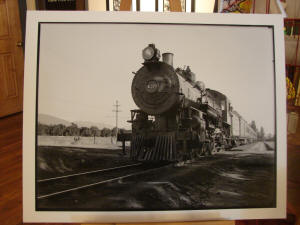|
 Patrick Moore is a historian. He may not see himself
as such, but the gathering of his work on the walls of the Lincoln
Art Institute at Thursday evening’s opening event for his show
certainly attests to that. Patrick has set his life’s work at
preserving the photographs of Howard Clinton Tibbitts and several
other photographers who worked at the turn of the 20th Century.
Tibbitts’ photo subjects depict a part of America that no longer
exists. Patrick Moore is a historian. He may not see himself
as such, but the gathering of his work on the walls of the Lincoln
Art Institute at Thursday evening’s opening event for his show
certainly attests to that. Patrick has set his life’s work at
preserving the photographs of Howard Clinton Tibbitts and several
other photographers who worked at the turn of the 20th Century.
Tibbitts’ photo subjects depict a part of America that no longer
exists.
Tibbitts was a part of a cadre of photographers working for the
railroads in the west and southwest during the first decades of the
20th Century. His subjects were the railroads themselves with iconic
steam engines and elegant passenger accommodations.
In addition he recorded the natural beauty of the American Southwest
and California, and the people who were a part of living in the
relatively new states of the west in a still young country. Looking
at his photos it is easy to see a country that no longer exists.
This is history.
Howard Clinton Tibbitts was born in California and had a natural
affinity for his home state and the southwest. Yet, little more is
known about him personally and no photographs of him exist. “There
is one photo he took that has his shadow in it, but that is as close
as we come to knowing what he looked like,” said Patrick Moore.

Tibbitts photos are a peek into early 20th Century America, but that
is not the only fascinating part of their history. In a day when
everyone has a fine camera on their phone and digital cameras that
can take hundreds of photos and store them on tiny memory cards, the
photography of the late 19th and early 20th Century was a chore.
Many of us know about the digital revolution in photography, and
prior to that we know about cameras that actually had film in them
that could be sent off to be developed. Tibbitts work preceded this
time by decades.

A field view camera
from the late 19th century that used glass plate negatives much like
the one Howard Tibbitts used. This one belongs to Patrick Moore, who
claims that it is still in working condition. While the use of dry
glass plates is history in most of the world, Pat has seen
contemporary photographers in England using it. “It was fascinating
to see the difficult process needed to take a photo and develop it
using glass plates,” he said.
The cameras that Tibbitts used were huge and could
only take one photo at a time - on glass, not film, not a memory
stick. The wet and dry glass plates of the era required specialized
skills to take and print the photos. We are not talking point and
shoot here.
Wet plates came first and had to be stored in a light
proof container. When the photographer wanted to take a photo, care
had to be taken to transfer the wet plate from its container into
the camera, making sure that no light reached the glass plate. Once
the plate was in the camera, a shroud surrounding the plate was
removed and the photo could be taken. The negative was then removed
from the camera and had to be fixed within fifteen minutes before
the wet emulsion containing the photo dried.
[to top of second column] |


The invention of dry plates was a significant step
forward as the plates could be stored for some time after being
removed from the camera before returning to the dark room to print
them.
Tibbitts and his cohorts carried pounds of bulky equipment to take
one photo at a time. One of the photos in the show is of a
photographer traveling through the mountains of the southwest with
his equipment on three pack horses.
Where does Patrick Moore come into the life of an early 20th Century
photographer?
“I have been fascinated with photography all of my life and
especially the early cameras,” Moore said.
“The qualities of the black and white photos taken in the early 20th
Century by Tibbitts are amazing because of the very slow shutter
speeds,” said Moore.
Moore has become a collector of glass plate negatives. Well, maybe
collector is an understatement. “I have become obsessed with the
glass plate negatives and the history they have recorded, the
history of our country and the history of photography itself,” he
said.
Moore has set about making prints of these negatives and sharing
them with the public. He scans the negatives, spends hours on the
computer removing tiny imperfections in them while being careful not
to alter the intent of the photographer, and then printing them on
watercolor paper.

A classic Tibbitts
photo of a steam engine.
When asked what his favorite scenes are from early
20th Century photos, he is quick to answer the ones with trains in
them. Patrick Moore’s day job is as a railroad engineer.
Logan County Arts member Mitch Douglas is responsible for bringing
Patrick Moore’s history exhibit to Lincoln. Mitch and Patrick are
old friends from their days working together on the railroad, and
both share a love of photography. Douglas often displays his
photography at the Lincoln Art Institute.
For those who were unable to make the opening of this fascinating
show, the Lincoln Art Institute will be open weekends from 1 p.m. to
4 p.m. Contact Moses Pinkerton for additional gallery hours at
217-651-8355.
[Curtis Fox]
 |